An AMD Threadripper X399 Motherboard Overview: A Quick Look at Seven Products
by Ian Cutress & Joe Shields on September 15, 2017 9:00 AM ESTASUS
ASUS enters the Threadripper arena with two motherboards available at launch: the Republic of Gamers Zenith Extreme and the Prime X399-A. A third board, the ROG Strix X399-E, is set to follow.
ASUS Republic of Gamers (ROG) X399 Zenith Extreme
The first board, the ROG Zenith Extreme, is positioned at the top of the ASUS X399 product stack. As is typical with ASUS Extreme motherboards, the aim is to include considerable numbers of features to support the high-end positioning. This means overengineering, extra cooling, overclocking functionality, extra support, and using higher end controllers such as 10G networking through a bundled add-in card. This is one of ASUS’ boards that also implements their custom DIMM.2 slot, which looks like a DRAM slot but actually supports enough PCIe lanes for two additional M.2 drives placed vertically.
As with most Threadripper motherboards, the Zenith has eight DDR4 memory slots for quad-channel memory, supporting a total of 128GB of both ECC and non-ECC memory. ASUS states a supported overclocked speed up to DDR4-3200, due to ASUS’ T-Topology trace layout, although users can overclock beyond this should they wish.
For the power delivery, the Zenith uses an eight phase design. This is paired with two heatsinks connected via a heatpipe, spreading the thermal capacity from above the VRM to near the IO. The heatsink near the IO has a finned portion to increase the surface area, and also includes a 40mm fan which sits under the I/O shield. It is designed to spin up only when needed, although based on our testing sample sent by AMD for the Threadripper launch, at max RPM it gets sufficiency loud. Power to the VRM is handled by two 8-pin EPS 12V ports located on the top right corner.
While any of the AM4 boards can overclock Threadripper, ASUS positions the Zenith as having a few more features on it compared to the others. This includes LN2 and Slow Mode switches, for users wanting an increased voltage range and/or have trouble getting to the OS under sub-zero conditions, as well as Retry and Safe Boot buttons for a failed POST. There are also switches to disable the PCIe Slots individually, to minimize any potential variation when really pushing the clock speeds under extreme cooling environments. The Zenith also has an external BCLK / base frequency generator, for additional flexibility when overclocking.
The Zenith supports SLI and Crossfire, which breaks down as x16/x8/x16/x8 from top to bottom with the full-length reinforced PCIe slots. The final PCIe x8 slot is actually bifurcated again to x4/x4, such that when the U.2 port is being used, the final slot shares half of its lanes with it, giving x16/x8/x16/x4 for the slots and x4 for U.2 functionality. There is also a PCIe 2.0 x4 slot from the chipset in the middle, with the aim of this slot to be for the ROG Areion 10G card which enables 10 gigabit Ethernet functionality to the system. This allows users with two graphics cards to get the best slot positioning as well as support for 10G and U.2 all in one system.
The main PCIe slots account for 48 of the onboard CPU PCIe lanes, which leaves 12 left. ASUS has put them to M.2 storage, where one slot is found underneath the heatsink and the other two are from ASUS’ custom DIMM.2 slot. DIMM.2, for those that haven’t seen it before, looks like a DRAM slot but uses a riser card to support a pair of additional 22110 M.2 drives. Three drives at four lanes a piece brings the total CPU lanes up to 60.
For network connectivity, the ROG Zenith Extreme also does something a little different. Under the normal networking category, we have a single Intel I211-AT gigabit Ethernet controller leading to one port on the rear panel. Users can equip the bundled 10G card for an additional Ethernet port as well. Under the abnormal networking category is the WiFi: ASUS has equipped the board with a WiFi card that supports both 2x2 802.11ac with MU-MIMO as well as 802.11ad 60 GHz WiGig. We first saw WiGig in action several years ago at MWC from Wilocity, and when that company were purchased by Dell we saw WiGig came to enterprise laptops. At the time it was a near-line-of-sight technology, working at less than 10 meters. ASUS states that combined with 802.11ac, their WiGig solution can support a combined speed up to 4600Mbps. As we’ve mentioned before, ASUS also includes their ROG Areion 10G expansion card, which uses the Aquantia AQtion AQC107 controller.
Audio functionality on the Zenith is handled by ROG SupremeFX, which incorporates ASUS’ version of Realtek’s ALC1220 (the ALC1220A) but also comes with an ESS SABRE9018Q2C integrated DAC/AMP for front panel ports, enabling better audio fidelity. By contrast, most Threadripper boards will use the ALC1220 in a custom audio profile, or Creative’s Core Sound3D. The S1220A, ASUS says, is a tweaked version of the ALC1220 by removing some of the unneeded functionality for lower power operation.
For USB, on the rear panel ASUS supports one USB 3.1 (10 Gbps) Type-C port from an ASM3142, one USB 3.1 (10 Gbps) Type-A port from the same ASM3142, and eight USB 3.1 (5 Gbps) ports from the CPU. For front panel connections, ASUS has an onboard USB 3.1 (10 Gbps) header from the chipset, two USB 3.1 (5 Gbps) headers from the chipset, and a single USB 2.0 header which shares connectivity with an ROG OC Panel.
The ROG Zenith has several RGB LEDs are integrated on the board. The main focal point is on the chipset heatsink, where with the ROG symbol illuminated, but the system also has RGB LEDs on the I/O cover and a long strip running the entire right side of the board. It is worth noting that the LEDs will remain switched on even after shutting down the machine by default. Adding more LEDs is possible, with two RGB headers on the board. All of the LEDs can be controlled by AURA Lighting Control software, bundled with the motherboard.
ASUS provided a block diagram showing exactly where devices are fed from on the Zenith. At the top we see the socket supporting four M.2 drives as well as four PCIe slots. The way the routing is presented between the final slot and the U.2 port might be confusing: the final set of x4 goes around to the quick switch, and if the U.2 is present it will support the U.2, and if not it will support the final PCIe slot, giving x8 connectivity.
From the chipset we see the SATA ports, the chipset USB 3.1 (10 Gbps) header, two USB 3.1 (5 Gbps) headers and a variety of PCIe slot allocations. The first PCIe allocation is in blue, two lanes of PCIe 2.0 being used to power the ASMedia ASM3142 controller, giving two ports of USB 3.1 (10 Gbps) on the rear panel, one of which is USB Type-C. The other PCIe lanes from the chipset go to the gigabit Ethernet (Intel I211-AT), two lanes for the 802.11ac/ad, four lanes for the middle PCIe slot, and another lane for a x1 slot.
| ASUS ROG Zenith Extreme | |
| Warranty Period | 3 Years |
| Product Page | Link |
| Price | $549.99 |
| Size | E-ATX |
| CPU Interface | TR4 |
| Chipset | AMD X399 |
| Memory Slots (DDR4) | Eight DDR4 Supporting 128GB Quad Channel Up to 3600 MHz (OC) |
| Network Connectivity | 1 x Intel I211-AT GbE 1 x Aquantia 10 GbE |
| Wireless Network | 802.11ad WiGig 802.11a/b/g/n/ac 2x2 MU-MIMO |
| Onboard Audio | SupremeFX Realtek S1220 ESS SABRE9018Q2C DAC |
| PCIe Slots for Graphics (from CPU) | 4 x PCIe 3.0 x16 Supports 4-Way SLI/CF |
| PCIe Slots for Other (from Chipset) | 1 x PCIe 2.0 x4 (max) 1 x PCIe 2.0 x1 |
| Onboard SATA | 6x Supporting RAID 0/1/10 |
| Onboard SATA Express | None |
| Onboard M.2 | 3 x PCIe 3.0 x4 (2 x PCIe + 1 x PCIe and SATA) |
| Onboard U.2 | 1 x PCIe 3.0 x4 |
| USB 3.1 | 1 x Type-A 1 x Type-C |
| USB 3.0 | 8 x Back Panel 2 x Header |
| USB 2.0 | 1 x Header |
| Power Connectors | 1 x 24-pin EATX 2 x 8-pin ATX 12V |
| Fan Headers | 1 x CPU 1 x CPU Opt 2 x Chassis 1 x H_AMP 1 x W_Pump+ 1 x 5-pin EXT_Fan (Extension Fan) |
| IO Panel | 1 x Intel GbE 1 x USB 3.1 Gen 2 Type-C 1 x USB 3.1 Gen 2 Type-A 8 x USB 3.1 Gen 1 1 x Optical S/PDIF out 1 x Clear CMOS button 1 x USB BIOS Flashback Button 1 x ASUS Wi-Fi GO! module 5 x LED-illuminated audio jacks |


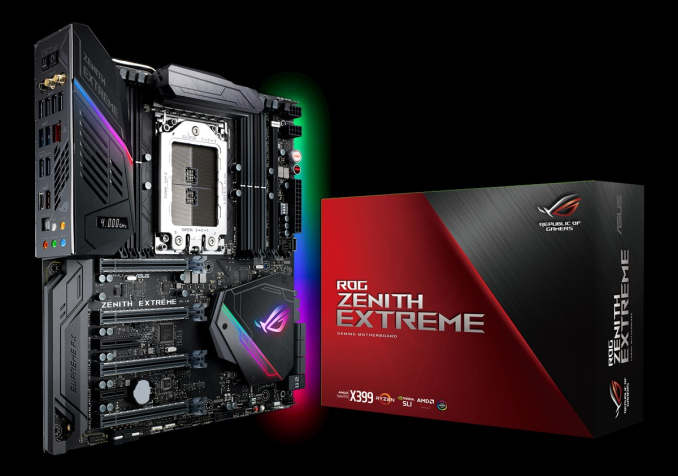
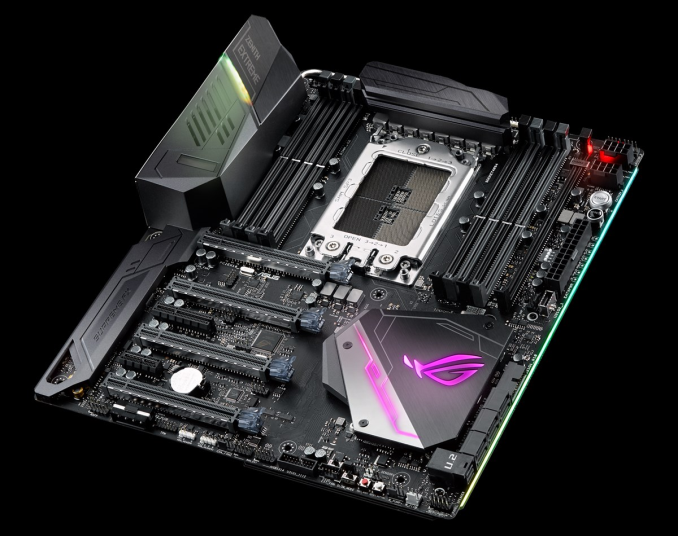
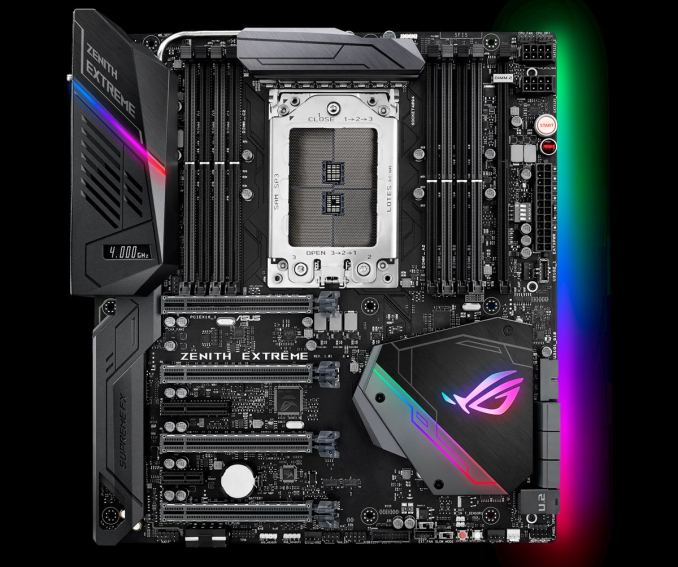




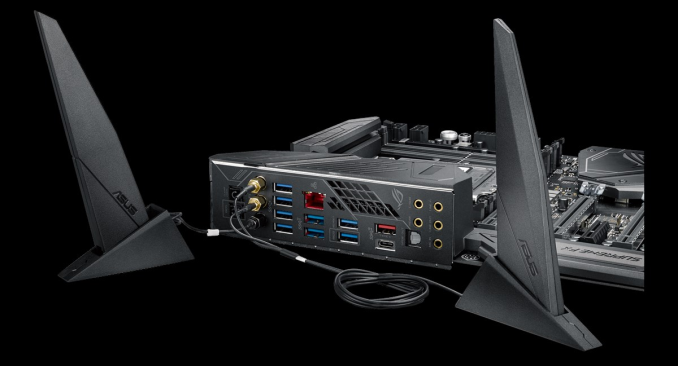
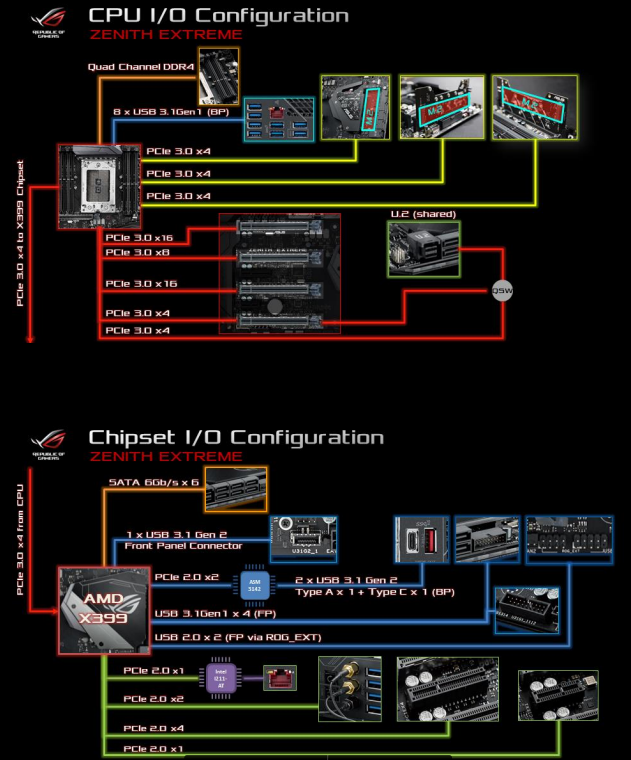








99 Comments
View All Comments
Vorl - Friday, September 15, 2017 - link
Heads up, the X399 Taichi product link is linked to the pro gaming motherboard link.milkod2001 - Friday, September 15, 2017 - link
Grossly overpriced boards. Cay they drop this LED nonsense & ugly plastics and make proper boards at reasonable $250?DanNeely - Friday, September 15, 2017 - link
The RGB cancer isn't why these boards are so expensive. It's stupid, but only adds a few dollars to the cost; not a few hundred.It's all the extra PCB layers they need to support the 4000 connections to the CPU socket and route all the extra PCIe lanes. Limiting the number of PCIe lanes in mainstream chips is as much about being able to use smaller sockets and fewer PCB layers to keep board costs down as it is a desire on AMD and Intel's part to upsell to X299/X399 systems. The fact that the mobo vendors are probably expecting to sell dozens of mainstream boards for every one of these halo products doesn't help either because it means that the R&D costs can't be spread anywhere near as widely.
For the two boards that have them, the $100 for a 10GB NIC doesn't help any.
tamalero - Sunday, September 17, 2017 - link
Still annoying and useless. They just wanted to appeal the extra gaming segment when this entire system is not for gaming.Now add the fact that almost every goddarn high end videocard AND memory now have shitty RGB lights as well.
Its a waste of power.
CheapSushi - Sunday, September 17, 2017 - link
Are you assuming enthusiasts are all just gamers? You can be an enthusiast that loves gaming AND content creation. If you want no-nonsense then maybe go EPYC instead (YES, it is a workstation platform too, not just server): http://b2b.gigabyte.com/Server-Motherboard/MZ31-AR...mapesdhs - Tuesday, September 19, 2017 - link
Amazing how many people just assume that a PC user is either a gamer or not a gamer. There's a lot of crossover with content creation these days, and also people who stream. Being able to play a game, record the gameplay, convert a previous session and upload it to YT/etc. will be a boon for those who make a living doing such things.CheapSushi - Sunday, September 17, 2017 - link
Finally a voice of reason for the naggers.ddarko - Friday, September 15, 2017 - link
Anyone interested in pairing the Asus Zenith Extreme with the Threadripper version of the Noctua NH-U14S should note that the cooler blocks the first PCI-E x16 slot on the board. Noctua says Asus didn't follow the AMD clearance guidance on this board; you can see in the pic that the top slot is very very close to the CPU bracket.glennst43 - Friday, September 15, 2017 - link
NH-U12S TR4-SP3 will fit though: http://noctua.at/en/nh-u12s-tr4-sp3/specification. I read a German article that showed that this cooler provides very similar cooling perf and noise as compared to the 14S. I have 2 other systems that use variations of the 14s, and I can not find any noticeable noise difference. Still an unfortunate design decision from Asus.DanNeely - Friday, September 15, 2017 - link
Other than the MSI board, I notice that none of them are putting USB2 ports on the back panel. Does that mean the interference problems that some USB2 devices encountered in 3.0 ports have been fixed; or that the mobo makers just feel anyone who needs them can use an IO bracket attached to an onboard header?